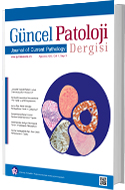BACKGROUND
Chromophobe renal cell carcinoma (ChRCC) is a morphologically distinct renal cell carcinoma type which may rarely show composite morphology. Heterologous differentiation in the form of osteosarcoma or chondrosarcoma is very rarely encountered.
CASE
A 46-year-old female presented with a ChRCC with sarcomatoid transformation containing osteosarcomatous and chondrosarcomatous differentiation. A radical nephrectomy specimen consisted of left kidney surrounded by perinephric adipose tissue and Gerota fascia. A 9.5×8×8 cm mass occupied most of the lower pole and displayed a gray-tan to yellow-tan tumor with areas of necrosis (40% of tumor), fibrosis, and calcification. The sections of kidney showed a biphasic, malignant epithelial and sarcomatoid neoplasm, with ChRCC as the carcinomatous element and a high-grade pleomorphic sarcoma as the sarcomatoid component. The latter displayed areas of osteosarcoma and chondrosarcoma. The sarcomatous element represented about 70% of the tumor, with 20% composed of osteosarcomatous and chondrosarcomatous components. Tumor necrosis was about 40% of the total tumor volume.
CONCLUSION
In general, the incidence of sarcomatoid transformation in RCC is around 5%. Less than 10 cases have been reported with a heterologous element such as chondrosarcoma, osteosarcoma or rhabdomyosarcoma. It is very important to recognize ChRCC as a distinct subtype of renal neoplasm, so much as the diagnosis implies a favorable prognosis to the patient. However, if sarcomatoid transformation develops, the patient’s prognosis is very poor.
Anahtar Kelimeler : kidney; pleomorphic sarcoma; sarcomatoid chromophobe renal cell carcinoma

